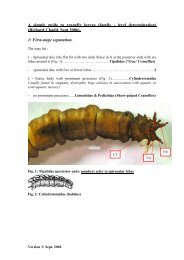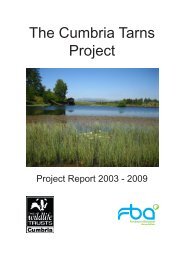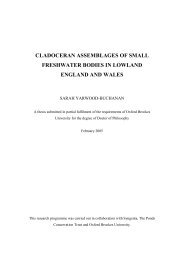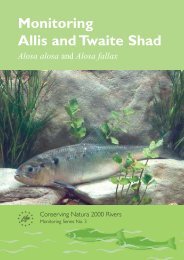Monitoring the Bullhead - European Commission
Monitoring the Bullhead - European Commission
Monitoring the Bullhead - European Commission
You also want an ePaper? Increase the reach of your titles
YUMPU automatically turns print PDFs into web optimized ePapers that Google loves.
or even 3 are deemed acceptable (Cowx 1996). Detection of large-scale shifts in <strong>the</strong> population<br />
characteristics that prevail over a number of years or between sites are considered adequate for<br />
meeting <strong>the</strong> objectives of assessing conservation status.This has distinct advantages, since <strong>the</strong> number<br />
of sites in a particular reach that must be sampled can be reduced, thus reducing resource needs for<br />
surveying.<br />
To determine <strong>the</strong> actual number of sampling sites that must be sampled, Bohlin et al. (1990) and Wyatt<br />
& Lacey (1994) provided detailed guidelines for fisheries survey design and analysis for various likely<br />
scenarios.These guidelines should be referred to if more detailed understanding of <strong>the</strong> principles<br />
underlying sampling <strong>the</strong>ory is needed.<br />
To determine <strong>the</strong> number of sites to be sampled, consider <strong>the</strong> case where stock size or mean density<br />
is assessed by a specific relative (catch per unit area or river bank length) or absolute method (Zippin<br />
or Carle & Strub) at each site.The precision is chosen as one of <strong>the</strong> classes previously suggested (CV =<br />
0.16 for bullheads). The number of sites is determined from:<br />
n = S(C pop 2+ CV(N i) 2)/(S x CV 2 + C pop 2)<br />
where Cpop is <strong>the</strong> spatial variation of population size among sites expressed as <strong>the</strong> coefficient of<br />
variation (standard deviation/mean) and CV(Ni) is <strong>the</strong> within sites sampling error, expressed as <strong>the</strong><br />
coefficient of variation (standard error/population size Ni) and CV precision class required expressed<br />
as standard error/mean (for purposes of bullheads CV = 0.16, see above). It is <strong>the</strong>refore necessary to<br />
have a measure of <strong>the</strong> variance in densities of <strong>the</strong> target population from surveys in <strong>the</strong> area being<br />
sampled before one can calculate <strong>the</strong> minimum sample number for <strong>the</strong> given precision level.The CV(Ni) can be determined from a pilot study or from data from similar populations collected during routine<br />
monitoring programmes (see example from rivers Eden and Teifi, Section 6).The following example<br />
clarifies <strong>the</strong> application of <strong>the</strong> method.<br />
In a upland river, <strong>the</strong> target area is sampled, as described below, at seven sites The mean population size<br />
per section and <strong>the</strong> standard deviation among sites were 127 and 86, respectively. Cpop is <strong>the</strong>refore<br />
86/127 = 0.68. To calculate <strong>the</strong> within-sites sampling error, a measure of catch efficiency is required,<br />
which must be derived from a multiple catch depletion sampling, such as used for calibration of<br />
sampling efficiency.The catch probability (P) using Zippin or Carle and Strub (1978) estimates (see<br />
Cowx 1983) was 0.60.Therefore CVi using P = 0.60, number of removals k = 3 and an average<br />
population size N = 127 can be calculated as follows.The sampling variance is determined as:<br />
V (Ni) = N i[(1 – q k) q k]/[(1 – qk) 2 – (kP) 2 q k–1]<br />
where P is catch probability, and q = 1–P.The standard error of <strong>the</strong> population is <strong>the</strong> root of this<br />
expression. The CV is <strong>the</strong>n:<br />
CV(N i) = √ [V (N i)] /N i<br />
For <strong>the</strong> example CV(N i) = 0.024. Finally, if <strong>the</strong> precision level of <strong>the</strong> assessment is set as Class 3, viz. CV<br />
= 0.16, <strong>the</strong> number of sites (n) required would be of <strong>the</strong> order of<br />
n = 92 (0.68 2 + 0.024 2) / ((92 x 0.16 2) + 0.68 2) = 15.11 = 15.<br />
<strong>Monitoring</strong> <strong>the</strong> <strong>Bullhead</strong><br />
If <strong>the</strong> level of precision is restricted to Class 2 (CV = 0.10), <strong>the</strong> sample size would be about 31, and for<br />
Class 1 (CV = 0.05) about 62 sites.<br />
Input data for undertaking <strong>the</strong> above procedure are gained ei<strong>the</strong>r from existing surveys on <strong>the</strong> river<br />
catchment or from preliminary field studies on <strong>the</strong> target catchment – for example, studies on <strong>the</strong><br />
rivers Eden and Teifi (Section 6). Such data probably do not exist for bullheads as <strong>the</strong>y are rarely<br />
sampled quantitatively, but, as a rule of thumb, approximately 40 sites should be surveyed in UK river<br />
catchments to provide an acceptable level of precision of <strong>the</strong> abundance of bullheads.<br />
11
















